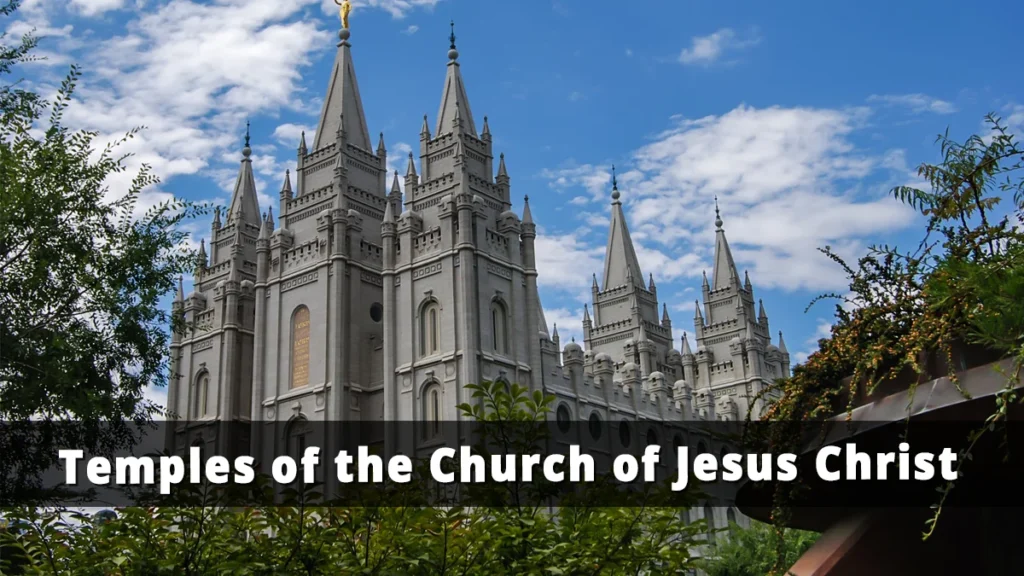Use Coupon FLAT10 for 10% OFF on Order over $100.
Temples of the Church of Jesus Christ of Latter-day Saints
Explore the significance, history, and architectural beauty of temples in the Church of Jesus Christ of Latter-day Saints.

Temples hold a significant place in the Church of Jesus Christ of Latter-day Saints (LDS Church), serving as sacred spaces for worship, ordinances, and spiritual growth. These temples, distinct from regular meetinghouses, are central to the faith and practice of millions of Latter-day Saints around the world. This article explores the history, significance, architectural features, and global impact of these revered structures, providing a comprehensive overview for both members of the Church and those interested in learning more about this aspect of the LDS faith.
Historical Context
Early History of Temples in the Church: The concept of temples in the LDS Church dates back to its early days in the 19th century. The first temple, built in Kirtland, Ohio, was dedicated in 1836. This temple set a precedent for future constructions, emphasizing the importance of having dedicated spaces for sacred ordinances and worship.
Key Milestones and Developments: Key milestones include the construction of the Nauvoo Temple in Illinois and the iconic Salt Lake Temple in Utah. Each new temple brought innovations in design and function, reflecting the growing needs of the Church’s membership and its expanding global presence.
Significance of Temples
Spiritual Importance: Temples are considered houses of the Lord, where members participate in sacred ordinances essential for their spiritual progression. These include baptisms for the dead, endowments, and sealings, which unite families for eternity.
Role in Worship and Community: Temples serve as places of peace and reflection, providing a respite from the world and a chance to connect with the divine. They also foster a sense of community among members, who share in the sacred experiences and responsibilities associated with temple worship.
Architectural Features
Common Architectural Elements: LDS temples are known for their distinctive and often grand architecture. Common features include spires, symbolic motifs, and high-quality materials. Each temple is designed to reflect both its spiritual purpose and its cultural setting.
Notable Design Aspects: Unique design aspects can be seen in temples like the Salt Lake Temple, with its six spires and detailed stonework, and the Laie Hawaii Temple, which features Polynesian architectural influences.
Famous Temples
Salt Lake Temple: The Salt Lake Temple, dedicated in 1893, is perhaps the most famous LDS temple. Located in Temple Square in Salt Lake City, Utah, it serves as a symbol of the Church and its heritage.
Temple Square: Temple Square itself is a major tourist attraction, featuring not only the Salt Lake Temple but also the Tabernacle, Assembly Hall, and various visitors’ centres.
Other Significant Temples: Other notable temples include the Washington D.C. Temple, the Los Angeles California Temple, and the Rome Italy Temple, each with its own unique history and architectural style.
Construction and Dedication
Process of Building a Temple: The construction of a temple is a meticulous process, often taking several years. It begins with the selection of a site, followed by detailed architectural planning, construction, and landscaping.
Dedication Ceremonies and Their Significance: Once a temple is completed, it is dedicated in a special ceremony, which includes prayers, hymns, and the symbolic act of “turning the key” to signify the temple’s readiness for use.
Temple Ordinances
Overview of Ordinances Performed: Temples are the exclusive locations for several key ordinances, including baptisms for the dead, endowments, and sealings. Each ordinance plays a vital role in the spiritual lives of members.
Importance of Each Ordinance: Baptisms for the dead allow living members to perform proxy baptisms for deceased ancestors, endowments provide spiritual instruction and covenants, and sealings bind families together for eternity.
Membership Requirements
Requirements for Entry: Entry to an LDS temple requires a temple recommend, a card issued by church leaders certifying that the member is in good standing and adheres to the Church’s teachings and standards.
Significance of the Temple Recommend: The temple recommend interview process is a time of reflection and commitment for members, ensuring that they are spiritually prepared to enter the temple and participate in its ordinances.
Global Expansion
Growth of Temples Worldwide: The LDS Church has seen remarkable growth in the number of temples worldwide, with over 160 operating temples and more announced or under construction. This expansion reflects the Church’s commitment to providing temple access to its global membership.
Impact on Global Membership: The increase in temples has strengthened the faith and unity of members around the world, providing more opportunities for participation in sacred ordinances and enhancing the sense of global community.
Cultural and Community Impact
Influence on Local Communities: Temples often become landmarks in their communities, contributing to the local culture and economy. They also provide opportunities for community service and interfaith dialogue.
Cultural Significance: In many cultures, temples are seen as symbols of peace, service, and spiritual commitment. They often host open houses before their dedication, allowing the public to tour and learn about the temple’s purpose and significance.
Technological Innovations
Use of Technology in Temple Construction and Maintenance: The Church employs advanced technology in the construction and maintenance of temples, including computer-aided design, sustainable building practices, and state-of-the-art security systems.
Virtual Temple Tours: In recent years, the Church has also offered virtual tours of temples, allowing people worldwide to experience their beauty and learn about their purpose from the comfort of their homes.
Future Prospects
Planned Temples and Expansions: The Church has announced plans for numerous new temples, reflecting its ongoing commitment to temple-building. These plans include temples in diverse locations, from major cities to remote areas.
Future Trends in Temple Architecture and Design: Future temple designs may incorporate more sustainable materials and practices, as well as technological advancements to enhance the experience for members and visitors.
Personal Stories and Testimonials
Experiences of Temple-Goers: Members often share personal stories of how temple worship has impacted their lives, providing inspiration, comfort, and a deeper connection to their faith.
Impact of Temples on Individual Lives: These stories highlight the transformative power of temple ordinances and the sense of peace and purpose they bring to individuals and families.
Expert Insights
Quotes and Advice from Church Leaders and Historians: Church leaders and historians provide valuable insights into the significance of temples, offering guidance and encouragement to members in their spiritual journeys.
Gifts by Jesus Final Thought
The temples of the Church of Jesus Christ of Latter-day Saints are more than just buildings; they are sacred spaces that play a vital role in the spiritual lives of members. From their rich history and architectural beauty to their global expansion and cultural impact, temples are central to the faith and practice of Latter-day Saints. As the Church continues to grow and build new temples, these sacred spaces will remain a beacon of peace, faith, and community for generations to come.
For those interested in learning more, visiting a temple open house, or exploring the history and significance of these sacred structures, further resources and opportunities are readily available. The journey to understanding and appreciating the temples of the LDS Church is a rewarding one, offering profound insights into the faith, devotion, and heritage of its members.



